Abagadasset Point Range Lights

This oil house is the only building that remains standing on the site of Maine’s Abagadasset Point Range Lights.
Ted Panayotoff
Thanks to the efforts of Ted Panayotoff of the Elms B&B in Camden, the site of Maine’s Abagadasset Point Range Lights has been located.
The Abagadasset Point Range Lights were located on the east bank of the Kennebec River about five miles above Bath and Woolwich. They were built to provide indication of safe passage around Abagadasset Point, which is on the west bank of the river opposite the range lights.
The range lights are first mentioned in the 1900 Light List with the remark that that “are to be established.” They were first lit on June 30, 1903. The first laborer-keeper, Dexter W. Baker, was appointed August 8, 1903 with an annual salary of $250. He was still serving in 1912. The lights were fixed red lights (lens lanterns) with the front light on a white post 15 feet high and 25 feet above mean water and the rear light was on a 26 foot white post 56 feet above mean high water. The rear light was 257 yards from the front light. A 1927 Coast Pilot refers to the range in instructions for transiting the Kennebec River to Gardiner and Augusta, Maine.
A 1935 Light List does not list the range lights, so they were probably discontinued and the site decommissioned sometime between 1927 and 1935 when the steamboats stopped running to Augusta.
Ted located the lights, or more accurately what remains of them, by using a hand-held GPS receiver programmed with the latitude and longitude coordinates of the lights. The location of the rear light is now in a power line right of way and covered with dense brush. If any of the structure remains it was well hidden and couldn’t be located without a difficult search.
However, the front light remains are quite recognizable. The oil house is still there; a bit worse for wear but considering its age, it was not in too bad of shape. The stumps of the tower are there along with a section of tower leg lying where it fell when it was cut down. One corner of the property is still marked with a granite “USLHE” marker.
There is a barely recognizable road leading to about 100 feet from the front light. At the end of the road there is a pile of debris, which seemed to be the remains of a small wooden structure. Whether it was related to the range lights was not evident from what was left of it. On this inspection trip the remains or site of a keeper’s house was not located, and in fact there may never have been one. The laborer-keeper was most likely what we often call a “lamp-lighter,” a person who lived nearby.
Unfortunately, its location and difficulty of access would seem to preclude saving anything beyond a few bricks from the oil house. If any of our readers can supply us with additional historical information or photographs please write to our Editor at P.O. Box 1690, Wells, ME 04090.
We congratulate Ted for locating and documenting this missing part of Maine’s lighthouse history.
All contents copyright © 1995 - 2010
by Lighthouse Digest®, Inc.
Download PDF of Article from Lighthouse Digest |


